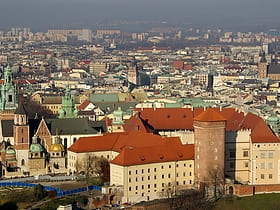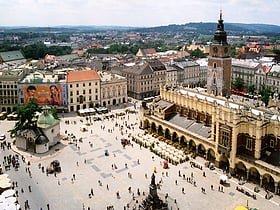Kraków: Neighbourhood
Places and attractions in the Neighbourhood category
Categories
- Museum
- Church
- History museum
- Gothic architecture
- Park
- Art museum
- Historical place
- Sacred and religious sites
- Baroque architecture
- Neighbourhood
- Specialty museum
- Cemetery
- Street
- Concerts and shows
- Universities and schools
- Memorial
- Theater
- Art gallery
- Synagogue
- Palace
- Monuments and statues
- Romanesque architecture
- Shopping
- Gothic Revival architecture
- Science museum
- Nightlife
- Arenas and stadiums
- Sport
- Sport venue
- Forts and castles
Dzielnica I Stare Miasto
Dzielnica I Stare Miasto is a district of the city of Kraków, Poland. The first administrative district covers a wider area than the Old Town of Kraków itself.
Kraków Old Town
Kraków Old Town is the historic central district of Kraków, Poland. It is one of the most famous old districts in Poland today and was the centre of Poland's political life from 1038 until King Sigismund III Vasa relocated his court to Warsaw in 1596.
Podgórze
Podgórze is a district of Kraków, Poland, situated on the right bank of the Vistula River, at the foot of Lasota Hill. The district was subdivided in 1990 into six new districts, see present-day districts of Kraków for more details.
Czyżyny
Czyżyny is one of 18 districts of Kraków, located in the central part of the city. The name Czyżyny comes from a village of same name that is now a part of the district.
Kazimierz
Kazimierz is a historical district of Kraków and Kraków Old Town, Poland. From its inception in the 14th century to the early 19th century, Kazimierz was an independent city, a royal city of the Crown of the Polish Kingdom, located south of the Old Town of Kraków, separated from it by a branch of the Vistula river.
Zwierzyniec
Zwierzyniec is one of 18 districts of Kraków, located in the western part of the city. The name Zwierzyniec comes from a village of same name that is now a part of the district.
Prądnik Czerwony
Prądnik Czerwony is one of 18 districts of Kraków; known as Dzielnica III, located in the northern part of the city. The name Prądnik Czerwony comes from a village of same name that is now a part of the district.
Łagiewniki-Borek Fałęcki
Łagiewniki-Borek Fałęcki is one of 18 districts of Kraków, located in the southern part of the city. The name Łagiewniki-Borek Fałęcki comes from two villages that are now parts of the district.
Dębniki
Dębniki is one of 18 districts of Kraków, located in the southwest part of the city. The name Dębniki comes from a village of same name that is now a part of the district. According to the Central Statistical Office data, the district's area is 46.19 square kilometres and 59 395 people inhabit Dębniki.
Grzegórzki
Grzegórzki is one of 18 districts of Kraków, located in the central part of the city. The name Grzegórzki comes from a village of same name that is now a part of the district. According to the Central Statistical Office data, the district's area is 5.85 square kilometres and 28 960 people inhabit Grzegórzki.
Kleparz
Kleparz is a neighbourhood in Kraków, Poland, situated directly to the north of the Old Town, marking the beginning of the Royal Road. It was a separate town between 1366 and 1792. It is now part of the Stare Miasto administrative district.
Krowodrza
Krowodrza is one of 18 districts of Kraków, located in the western part of the city. The name Krowodrza comes from a village of same name that is now a part of the district.
Podgórze Duchackie
Podgórze Duchackie is one of 18 districts of Kraków, located in the southern part of the city. The name Podgórze Duchackie comes from two villages that are now parts of the district.
Swoszowice
Swoszowice is one of 18 districts of Kraków, located in the southern part of the city. The name Swoszowice comes from a village of same name that is now a part of the district.
Wzgórza Krzesławickie
Wzgórza Krzesławickie is one of 18 districts of Kraków, located in the northeast part of the city. The name Wzgórza Krzesławickie comes from a village named Krzesławice that is now a part of the district.
Bieńczyce
Bieńczyce is one of 18 districts of Kraków, located in the northern part of the city. The name Bieńczyce comes from a village of same name that is now a part of the district. According to the Central Statistical Office data, the district's area is 3.70 square kilometres and 42 633 people inhabit Bieńczyce.
Tyniec
Tyniec is a historic village in Poland on the Vistula river, since 1973 a part of the city of Kraków. Tyniec is notable for its Benedictine abbey founded by King Casimir the Restorer in 1044.
Bronowice
Bronowice is one of 18 districts of Kraków, located in the western part of the city. The name Bronowice comes from a village of same name that is now a part of the district.
Bronowice Małe
Bronowice Małe is a neighborhood of Krakow, part of the Bronowice district.
Prądnik Biały
Prądnik Biały is one of 18 districts of Kraków, located in the northwest part of the city. The name Prądnik Biały comes from a village of same name that is now a part of the district.
Bieżanów-Prokocim
Bieżanów-Prokocim is one of 18 districts of Kraków, located in the southeast part of the city. The name Bieżanów-Prokocim comes from two villages that are now parts of the district.
Mistrzejowice
Mistrzejowice is one of the 18 districts of Kraków; known as Dzielnica XV, located in the northern part of the city. The name Mistrzejowice comes from a village of same name that is now a part of the district.
Przegorzały
Przegorzały is a town in the Zwierzyniec district of Kraków, located 6.5 kilometres west of the city centre. Przegorzały is at the edge of the Wolski Woods, east of Bielany and west of the Kościuszko Mound, overlooking the Vistula river.
Rakowice
Rakowice, formerly a village – is an urban area in Kraków, Poland, part of both: District III Prądnik Czerwony and District XIV Czyżyny. Currently, the neighborhood is heavily urbanized, with a small amount of parks. The predominant structures are apartment buildings and detached houses.
Map
























